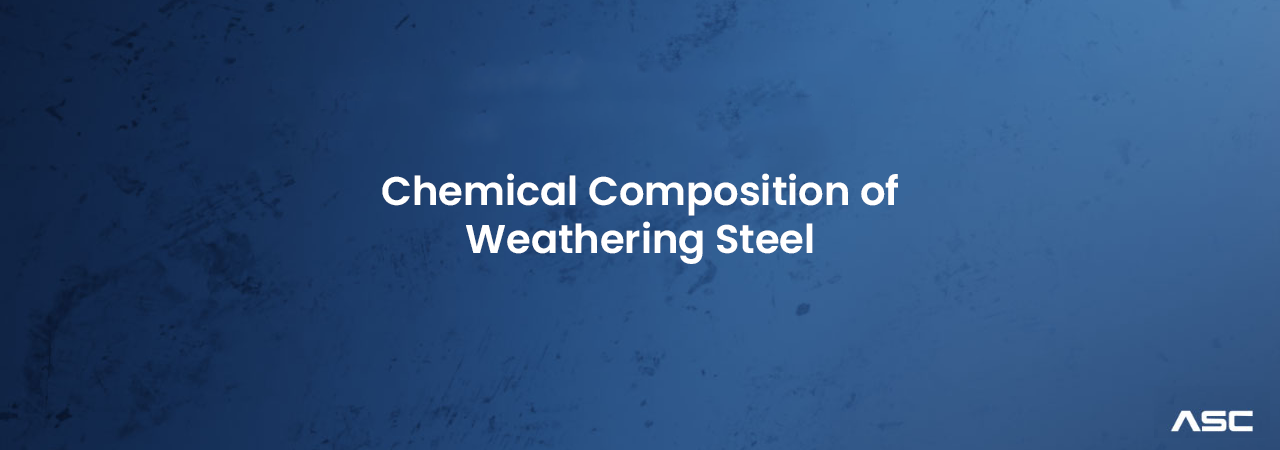Chemical Composition of Weathering Steel

Weathering steel, also known as COR-TEN steel, is a popular material in construction and architecture due to its unique properties. Understanding its chemical composition is crucial to appreciating why it performs so well in various environments.
What is Weathering Steel?
Weathering steel is a high-strength, low-alloy steel that develops a rust-like appearance over time. Unlike regular steel, it forms a stable, protective oxide layer when exposed to the weather. This makes it ideal for structures like bridges, buildings, and sculptures that need to withstand harsh outdoor conditions.
Corten Steel Grades
Corten A Weathering Steel
Corten A is a specific type of weathering steel that is specially designed for better corrosion resistance and aesthetic appeal. It is created by alloying copper, chromium, and nickel. Additionally, Corten A contains phosphorous, which makes it ideal for gas flue applications and aesthetic facias. However, it’s not recommended for heavy load-bearing applications; for such purposes, Corten B or S355J2W should be used.
The top layer of Corten A reacts with atmospheric elements to form a rust-colored protective layer. This layer not only makes the steel virtually maintenance-free but also gives it a pleasing and consistent finish.
Chemical Composition of Corten A
| C | 0.15 |
|---|---|
| Si | 0.25/0.75 |
| Mn | 0.20/0.50 |
| P | 0.07/0.15 |
| S | 0.030 |
| Al | 0.015/0.06 |
| Cu | 0.25/0.55 |
| Cr | 0.50/1.25 |
| Ni | 0.65 |
Corten B Weathering Steel
Corten B is better suited for heavy and load-bearing structures. Like Corten A, it forms its own protective layer when exposed to atmospheric elements. The top layer corrodes, protecting the steel beneath it. This natural finish usually doesn’t require any maintenance, such as painting, making it a highly cost-effective alternative to other structural steels.
However, painting and maintenance will be required if the structure is continually wet, as the protective layer won’t form under such conditions. An example is where the base of the structure meets the ground or is partially submerged.
Chemical Composition of Corten B
| C | 0.19 |
|---|---|
| Si | 0.30/0.65 |
| Mn | 0.80/1.25 |
| P | 0.035 |
| S | 0.030 |
| Al | 0.020/0.06 |
| V | 0.02/0.10 |
| Cu | 0.25/0.40 |
| Cr | 0.40/0.65 |
| Ni | 0.40 |
Chemical Composition of Weathering Steel
Weathering steels are high-strength, low-alloy steels with a carbon content of less than 0.2%, which provides adequate formability and weldability. The primary elements in weathering steels include:
- Carbon (C): Less than 0.2%, enhancing formability and weldability.
- Manganese (Mn): Improves toughness and hardness.
- Phosphorus (P): Enhances atmospheric corrosion resistance.
- Sulfur (S): Kept low to avoid brittleness.
- Silicon (Si): Enhances strength and helps form the protective oxide layer.
- Nickel (Ni): Increases toughness and corrosion resistance.
- Chromium (Cr): Significantly improves corrosion resistance.
- Copper (Cu): Crucial for forming the protective oxide layer.
- Vanadium (V): Enhances strength and toughness.
Weathering steels have a tensile strength of 70 ksi (kilopounds per square inch) and a tensile yield strength of 50 ksi.
How the Composition Affects Performance
The unique combination of these elements makes weathering steel highly resistant to corrosion. When exposed to the elements, it forms a stable, rust-like appearance that prevents deeper corrosion. This rust layer, known as the patina, acts as a protective barrier, reducing the need for painting and maintenance. The patina regenerates continuously when exposed to weather, providing ongoing protection against corrosion. The blend of strength, toughness, and resistance to atmospheric conditions makes it an excellent choice for long-lasting structures.
Benefits of Weathering Steel: Weathering steel offers several advantages:
- Longevity and Low Maintenance: Its corrosion resistance reduces the need for regular upkeep, making it cost-effective over time.
- Aesthetic Appeal: The natural, rustic appearance of weathering steel can enhance the visual appeal of structures.
ASTM Specifications for Weathering Steels
Weathering steels are a family of ASTM specifications, as well as several trademarked specifications, that exhibit similar corrosion-resistant properties. The ASTM specifications include:
- ASTM A588: Covers structural shapes, plate, and bar.
- ASTM A242: Covers steel plate up to one-half inch in thickness.
- ASTM A606-4: Covers steel sheet and strip.
- ASTM A847: Covers cold-formed welded and seamless high-strength, low-alloy structural tubing.
- ASTM A871-65: Covers high-strength, low-alloy structural steel plate.
- ASTM A709-50W: Covers weathering steel for bridges.
For those looking to utilize weathering steel in their projects, selecting the right type is crucial. Weathering steel is available in various grades, specifications, and shapes, suitable for different applications. Choosing the appropriate type can save time and money on additional processing.
Corten Steel Tube for High Strength Weathering Steels
Established in 1984, Corten Steel Tube specializes in distributing High Strength Weathering, High Strength, and Abrasion Resistant Steel products. Our experienced sales representatives can help you determine the best type of steel for your project.
Contact us to ensure you get the right material for your needs, maximizing the benefits of weathering steel in your construction or architectural projects.

